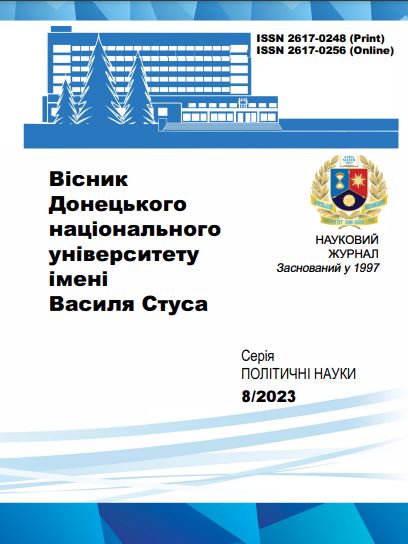Effectiveness of norms of collective actions
DOI:
https://doi.org/10.31558/2617-0248.2023.8.14Keywords:
sphere of public policy; emergence; civil society; collective behavior; norms; political actors; public eventAbstract
Collective behavior can be influenced by norms that arise as a result of an event that may be ambiguous and unclear. In order to determine a certain attitude to an event and define its meaning, the event must be defined. And only after it has acquired clear models and principles of interaction between actors within it, norms are configured. Thus, social norms become a consequence of collective behavior, and the actors themselves are defined in the public field.
Today, theories of collective behavior focus not only on emotions as a set of random actions. Increasingly, they require a search for rationality, especially when it comes to the use of online tools in organizing public events. As informal social rules that are enshrined in collective action, norms regulate collective behavior. They have the ability to change not only under the influence of formal institutions, but can also indicate their inability to do so. At the same time, informal institutions prove to be more effective in organizing stability. Even in the context of a protest movement. They are able to predict collective behavior, influence collective coordination, and coordinate the behavior of political and non-political actors. And in the face of collective threats to society, where social norms can emerge through informal institutions, coordination of behavior occurs much faster than under the influence of formal institutions.
References
Тлумачний термінологічний словник з конституційного права (2016).За заг. ред. д. ю. н., проф. Л. Р. Наливайко. К.: «Хай-Тек Пресс», 628 с.
Samuelson C. D. (2022). Why were the police attacked on January 6th? Emergent norms, focus theory, and invisible expectations. Group Dynamics: Theory, Research, and Practice. Vol. 26, No. 3, 178–198.
Thomas E. F., McGarty C., & Mavor K. (2016). Group interaction as the crucible of social identity formation: A glimpse at the foundations of social identities for collective action. Group Processes & Intergroup Relations, 19(2), 137–151.
Turner R., Killian L. (1993). Collective Behavior. 4th ed. Englewood Cliffs, N. J., Prentice Hall. 414 р.
Wood, M. M., Mileti, D. S., Bean, H., Liu, B. F., Sutton, J., & Madden, S. (2018). Milling and public warnings. Environment and Behavior, 50(5), 535-566.

